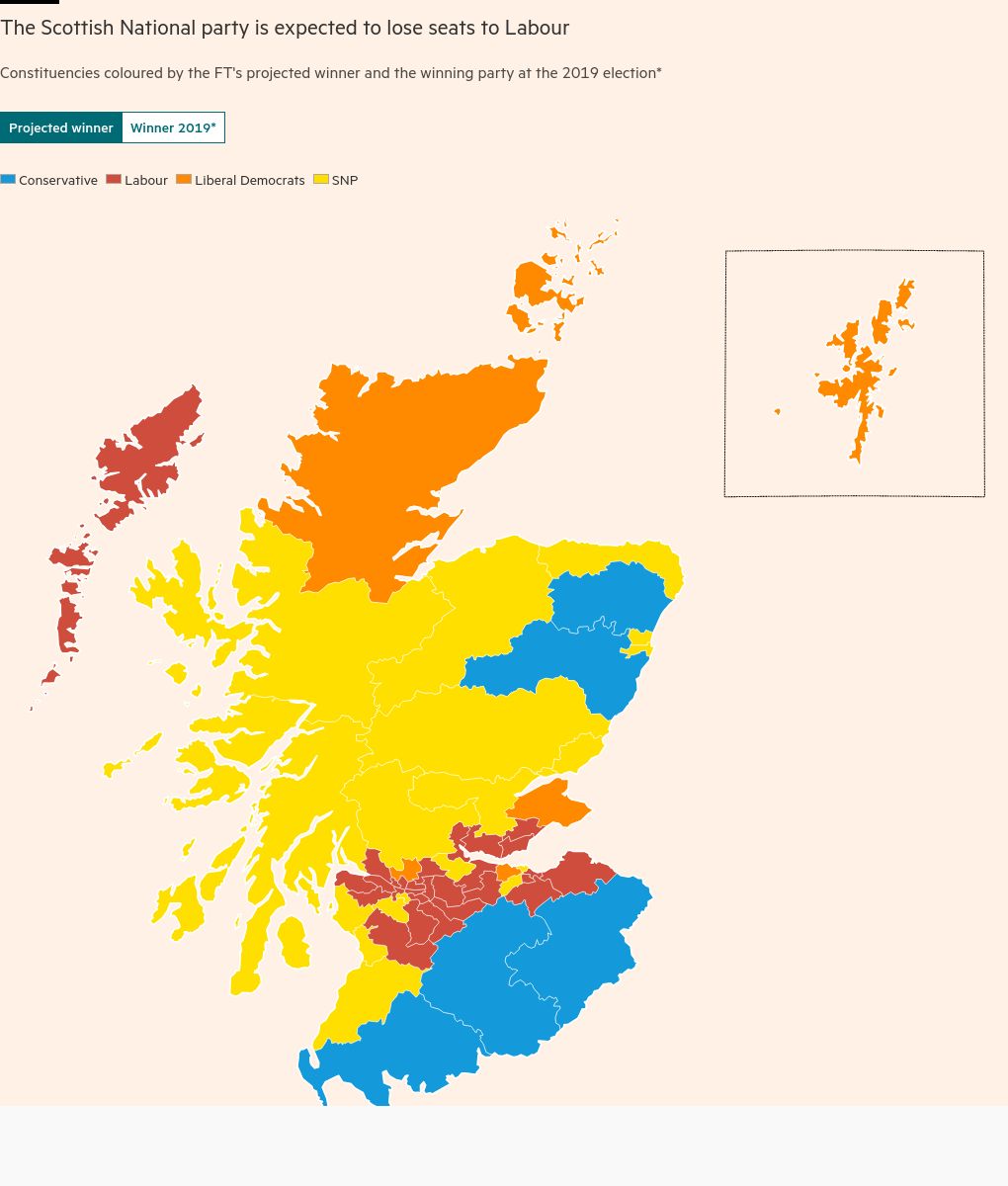
Unlock the Editor’s Digest for free
Roula Khalaf, Editor of the FT, selects her favourite stories in this weekly newsletter.
The UK will elect its next parliament on Thursday — but the full outcome will not be known until the early hours of Friday morning.
Polls predict the UK’s political map will be fundamentally redrawn by a historic victory for Sir Keir Starmer’s Labour party after 14 years of Conservative rule.
Here is what to expect and watch for on Thursday and Friday.
Results timing
Broadcasters will publish the findings of an exit poll estimating the results of the election at about 10pm on Thursday, seconds after polling stations close to voters. Compiled by pollster Ipsos, it is based on mock ballot papers filled in at 130 nationwide polling stations.
The exit poll was highly accurate in 2019 when it projected an 86-seat majority for the Tories, six seats more than the final result.
Actual constituency results will trickle in overnight, though planned timings may slip depending on how long it takes to count the votes.
Shortly before midnight, Blyth and Ashington in the North East of England is expected to make the first declaration, closely followed by Houghton and Sunderland South.
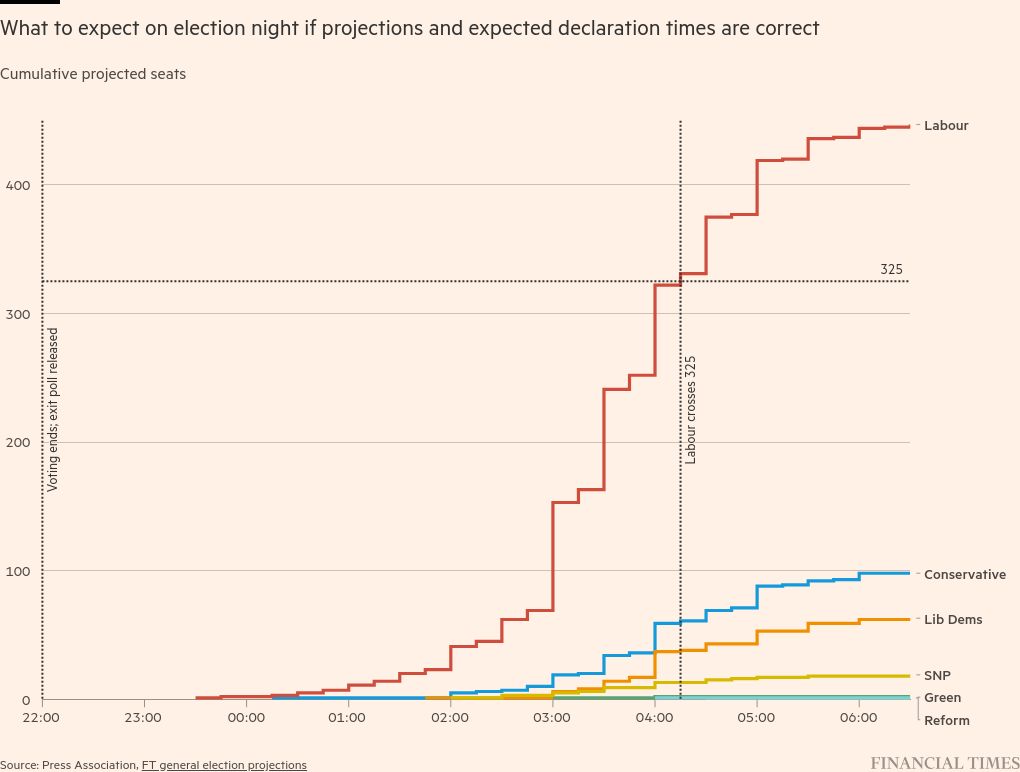
From roughly 2.00am on Friday, the number of results will pick up, with the Financial Times forecasting that Labour — if polls are correct — is likely to have a clear majority by about 4.15am.
Around this time, Sunak’s seat of Richmond in North Yorkshire will be declared and he will give his first speech of the evening, potentially conceding the race.
Starmer’s London seat of Holborn & St Pancras is expected to announce its results shortly after Sunak’s, giving him a platform to address voters.
Starmer may plan to make a separate appearance — when Tony Blair won his 1997 landslide, his acceptance remarks in his Sedgefield seat were followed by a formal victory speech in London only hours later.
‘Portillo’ moments
The fracturing of the Conservative vote has turned safe seats into tight contests that could yield a “Portillo moment” — a reference to Tory cabinet minister Michael Portillo unexpectedly losing his seat in the 1997 New Labour landslide.
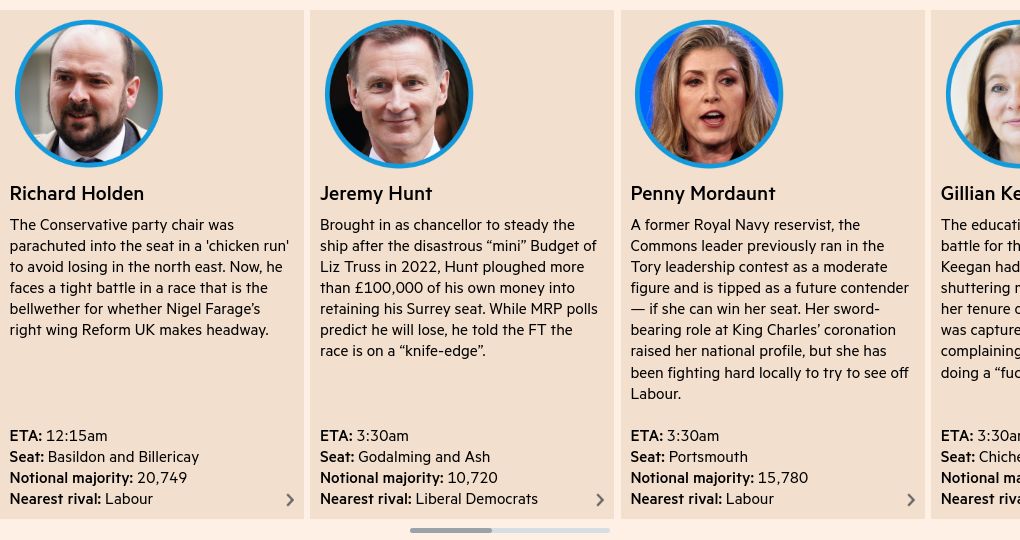
Potential Labour losses
Although polls predict Labour is on course for a significant national victory, there are several races where local factors and strong personalities could result in the party’s candidates being defeated.
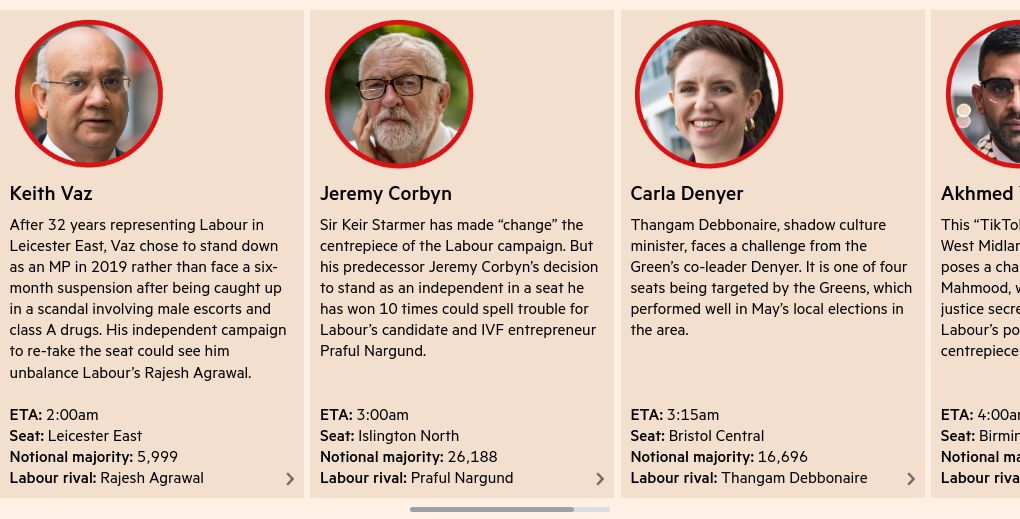
Rebuilding the Red Wall and a Labour ‘supermajority’
Labour will be eager to take back the “red wall” seats in the north of England that it lost to Boris Johnson’s Conservatives in the 2019 election.
While some voters who switched allegiance are anticipated to return to Labour, some are expected to back the populist Reform UK party.
Recovering seats such as Great Grimsby and Cleethorpes, and Scunthorpe, would be a significant morale boost, and a sign that the party is on course to win back its historic heartlands.
The Conservatives have warned of a Labour “supermajority”, which is not a technical term but merely an indication of the extent of its potential victory.
While most large-scale polls have the party on course for a sizeable majority, securing even a slim majority requires a larger swing to Labour than it secured in its 1997 landslide win.

Liberal Democrats: will stunts translate to votes?
Sir Ed Davey has spent much of the campaign engaged in a relentless pursuit of attention: falling off a paddle-board, bungee jumping, hurtling down a water slide.
Now, his party looks set to make a splash in Thursday’s poll. Some forecasts even suggest the Lib Dems could become the second largest in parliament, propelling Davey to become leader of the opposition. Its recent record result was in 2005, when it secured 62 seats.
In a sign of optimism, he engaged activists in a last-minute “Project A30” election offensive in towns bordering the A30 trunk road in Conservative heartlands in the South West, areas it had once considered “out of reach”.
Seats such as St Ives, North Cornwall, Honiton, Torbay, South Devon and West Dorset will be ones to watch, while Labour have tacitly conceded these races by focusing campaigners elsewhere.
While parties often play up their record in office, the Lib Dems have made little of their period in coalition with the Tories from 2010 to 2015: Davey’s deputy Daisy Cooper stumbled in a seven-way debate when asked about university tuition fees, which trebled while Davey was a minister.
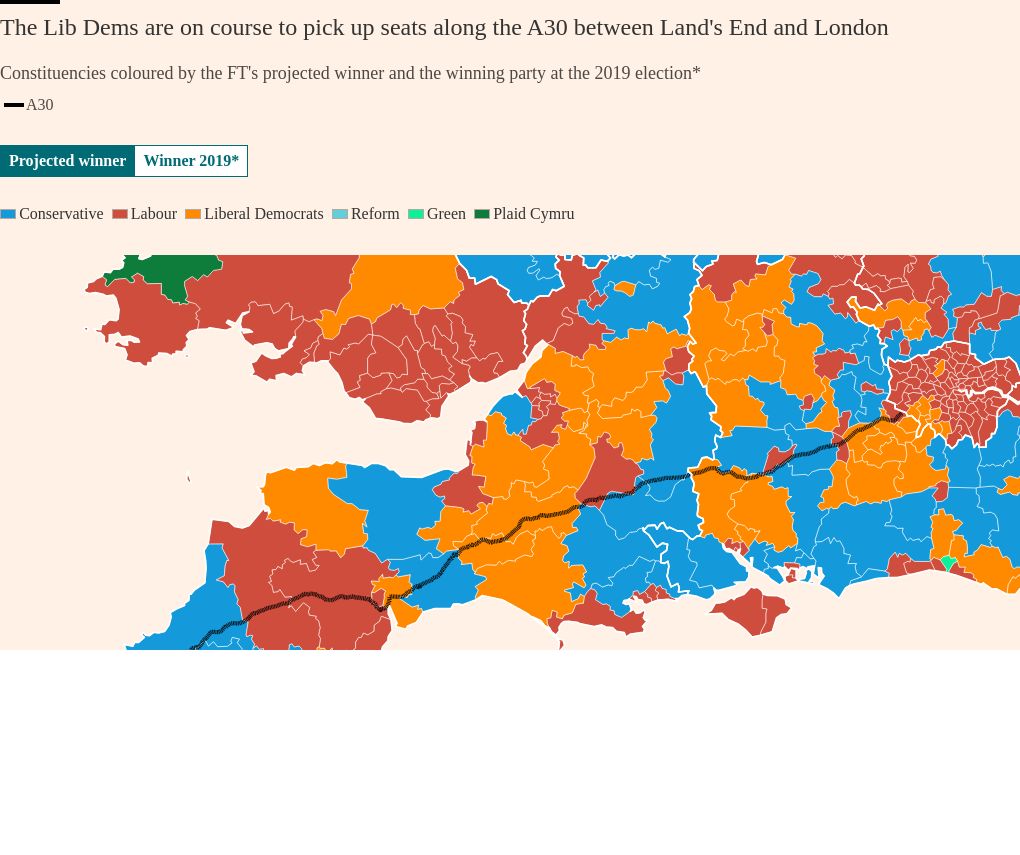
Will Nigel Farage enter parliament?
Reform UK — rebranded from the Brexit Party — is expected to cost the Tories dozens of seats by splitting the right-wing vote and letting in Labour or Lib Dem candidates.
Of the handful of seats it is seriously contesting, the most focus will be on Clacton, where leader Nigel Farage is making his eighth attempt to become an MP.
Farage considers this year’s race a springboard for the 2029 election and is focused on pushing the Tories into third place in a number of seats.
In 2015 the UK Independence Party — the spiritual predecessor to Reform — came second in 120 seats, a target that Reform will be taking as an unofficial benchmark of its appeal.
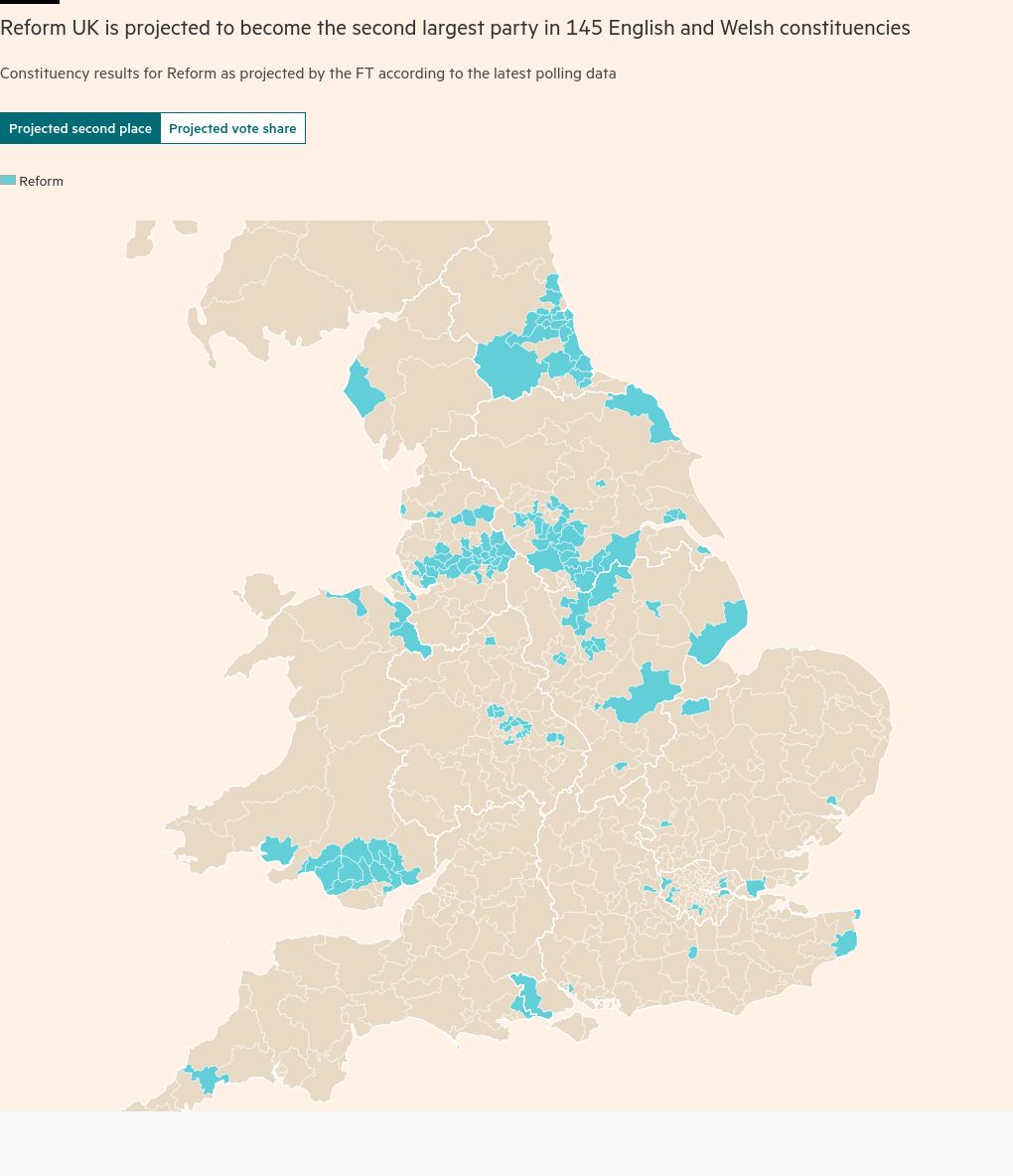
Collapse of the SNP in Scotland
The Scottish National party has won a majority of the devolved nation’s seats in Westminster for close to a decade, but its fortunes have faded after 17 years of running the Scottish government and several internal party scandals.
The battle in Scotland — traditionally a Labour stronghold — will be shaped by two fights: in the central belt and north east.
Progressive voters in Glasgow and Edinburgh have backed the SNP in recent Westminster elections. But Labour and the Scottish Greens — a separate party affiliated with the Greens in England and Wales — are making headway in seats that could wind up as three-way marginals.
In the north-east of Scotland, the Lib Dems are hoping to cut through in areas that have been fought between the SNP and Conservatives. These rural seats will add to the radically different tapestry that emerges in this contest.
